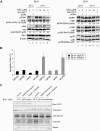Rac1 targeting suppresses p53 deficiency-mediated lymphomagenesis
- PMID: 20179179
- PMCID: PMC2858481
- DOI: 10.1182/blood-2009-02-202440
Rac1 targeting suppresses p53 deficiency-mediated lymphomagenesis
Abstract
Mutation of the p53 tumor suppressor is associated with disease progression, therapeutic resistance, and poor prognosis in patients with lymphoid malignancies and can occur in approximately 50% of Burkitt lymphomas. Thus, new therapies are needed to specifically target p53-deficient lymphomas with increased efficacy. In the current study, the specific impact of inhibition of the small GTPase Rac1 on p53-deficient B- and T-lymphoma cells was investigated. p53 deficiency resulted in increased Rac1 activity in both B-cell and T-cell lines, and its suppression was able to abrogate p53 deficiency-mediated lymphoma cell proliferation. Further, Rac targeting resulted in increased apoptosis via a p53-independent mechanism. By probing multiple signaling axes and performing rescue studies, we show that the antiproliferative effect of Rac1 targeting in lymphoma cells may involve the PAK and Akt signaling pathway, but not the mitogen-activated protein (MAP) kinase pathway. The effects of inhibition of Rac1 were extended in vivo where Rac1 targeting was able to specifically impair p53-deficient lymphoma cell growth in mouse xenografts and postpone lymphomagenesis onset in murine transplantation models. Because the Rac1 signaling axis is a critical determinant of apoptosis and tumorigenesis, it may represent an important basis for therapy in the treatment of p53-deficient lymphomas.
Figures







Similar articles
-
RLIP76 is overexpressed in human glioblastomas and is required for proliferation, tumorigenesis and suppression of apoptosis.Carcinogenesis. 2013 Apr;34(4):916-26. doi: 10.1093/carcin/bgs401. Epub 2012 Dec 30. Carcinogenesis. 2013. PMID: 23276796
-
Gain of function mutant p53 protein activates AKT through the Rac1 signaling to promote tumorigenesis.Cell Cycle. 2020 Jun;19(11):1338-1351. doi: 10.1080/15384101.2020.1749790. Epub 2020 Apr 10. Cell Cycle. 2020. PMID: 32275841 Free PMC article.
-
Rac1 inhibits apoptosis in human lymphoma cells by stimulating Bad phosphorylation on Ser-75.Mol Cell Biol. 2004 Jul;24(14):6205-14. doi: 10.1128/MCB.24.14.6205-6214.2004. Mol Cell Biol. 2004. PMID: 15226424 Free PMC article.
-
Dysfunction of the TP53 tumor suppressor gene in lymphoid malignancies.Blood. 2012 Apr 19;119(16):3668-83. doi: 10.1182/blood-2011-11-366062. Epub 2012 Jan 24. Blood. 2012. PMID: 22275381 Free PMC article. Review.
-
Review of alterations of the cyclin-dependent kinase inhibitor INK4 family genes p15, p16, p18 and p19 in human leukemia-lymphoma cells.Leukemia. 1998 Jun;12(6):845-59. doi: 10.1038/sj.leu.2401043. Leukemia. 1998. PMID: 9639410 Review.
Cited by
-
miR-142: A Master Regulator in Hematological Malignancies and Therapeutic Opportunities.Cells. 2023 Dec 30;13(1):84. doi: 10.3390/cells13010084. Cells. 2023. PMID: 38201290 Free PMC article. Review.
-
Rac GTPases in Hematological Malignancies.Int J Mol Sci. 2018 Dec 14;19(12):4041. doi: 10.3390/ijms19124041. Int J Mol Sci. 2018. PMID: 30558116 Free PMC article. Review.
-
RCC2 is a novel p53 target in suppressing metastasis.Oncogene. 2018 Jan 4;37(1):8-17. doi: 10.1038/onc.2017.306. Epub 2017 Sep 4. Oncogene. 2018. PMID: 28869598 Free PMC article.
-
Kinase requirements in human cells: V. Synthetic lethal interactions between p53 and the protein kinases SGK2 and PAK3.Proc Natl Acad Sci U S A. 2010 Jul 13;107(28):12463-8. doi: 10.1073/pnas.1007462107. Epub 2010 Jun 28. Proc Natl Acad Sci U S A. 2010. PMID: 20616055 Free PMC article.
-
Rac1/PAK1 signaling contributes to bone cancer pain by Regulation dendritic spine remodeling in rats.Mol Pain. 2023 Jan-Dec;19:17448069231161031. doi: 10.1177/17448069231161031. Mol Pain. 2023. PMID: 36938611 Free PMC article.
References
-
- Jaffe ES, Diebold J, Harris NL, Muller-Hermelink HK, Flandrin G, Vardiman JW. Burkitt's lymphoma: a single disease with multiple variants: the World Health Organization classification of neoplastic diseases of the hematopoietic and lymphoid tissues. Blood. 1999;93:1124. - PubMed
-
- Harris NL, Horning SJ. Burkitt's lymphoma–the message from microarrays. N Engl J Med. 2006;354:2495–2498. - PubMed
-
- Adams JM. Oncogene activation by fusion of chromosomes in leukaemia. Nature. 1985;315:541–542. - PubMed
-
- Bhatia K, Gutierrez M, Magrath IT. Burkitt's lymphoma cells frequently carry monoallelic DJ rearrangements. Curr Top Microbiol Immunol. 1992;182:319–324. - PubMed
-
- Capoulade C, Bressac-de Paillerets B, Lefrere I, et al. Overexpression of MDM2, due to enhanced translation, results in inactivation of wild-type p53 in Burkitt's lymphoma cells. Oncogene. 1998;16:1603–1610. - PubMed
Publication types
MeSH terms
Substances
Grants and funding
LinkOut - more resources
Full Text Sources
Other Literature Sources
Medical
Research Materials
Miscellaneous

